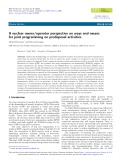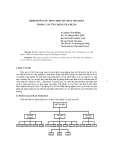
Waste and recycling
-
Nuclear decommissioning is a worldwide competitive market. It is also the main source of radioactive waste from the nuclear energy field. In order to reduce the waste volume it is necessary to sort the actual radioactive waste to be disposed of and to separate them from other materials that could be recycled.
 5p
5p  christabelhuynh
christabelhuynh
 29-05-2020
29-05-2020
 10
10
 0
0
 Download
Download
-
Tóm tắt: Bài báo trình bày tổng quan về tình hình chất thải rắn ở Việt Nam và các giải pháp có thể tái sử dụng chúng trong các ứng dụng xây dựng. Summary: This paper presents an overview on solid wastes in Viet Nam and solutions to recycle them in construction applications. I. ĐẶT VẤN ĐỀ Hiện nay ở Việt Nam song song với quá trình công nghiệp hoá, đô thị hoá là vấn đề xử lý các chất thải rắn từ công nghiệp và sinh hoạt. Hàng năm khối lượng các chất thải rắn tạo ra từ các ngành...
 7p
7p  thulanh2
thulanh2
 07-09-2011
07-09-2011
 142
142
 34
34
 Download
Download
-
Waste generated for the during the red mud, an industrial ore, aqueous the byproduct, is recycled solution. such processing of were congo of bauxite red from adsorption kinetics Adsorption studied using dose, parameters time as dye concentration, Adsorption adsorption isotherms. dye was followed data The 4.05 adsorbent first rate both agitation The and red to and pH.
 17p
17p  tudoia
tudoia
 06-04-2011
06-04-2011
 101
101
 8
8
 Download
Download












